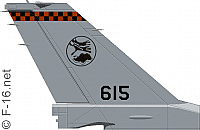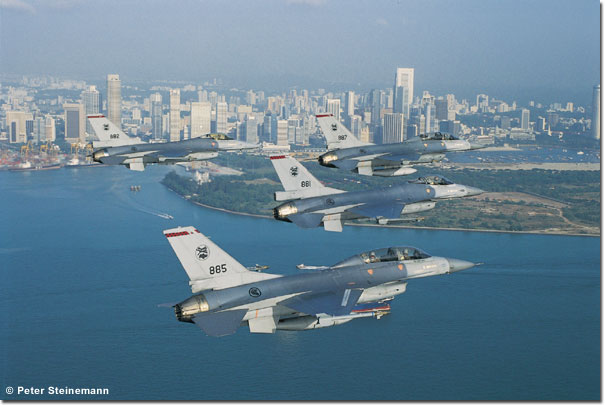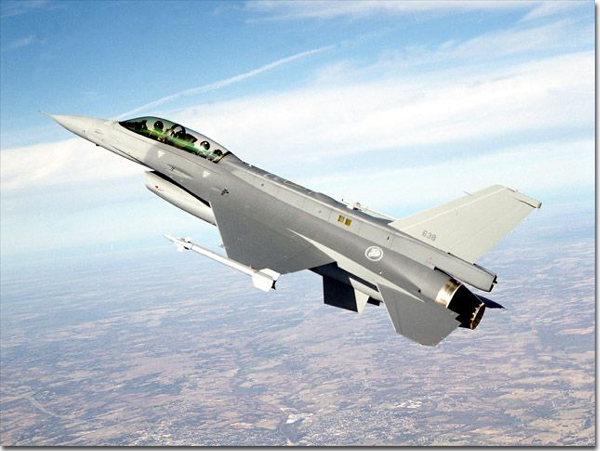Introduction
The Republic of Singapore Air Force operates 62 F-16 Fighting Falcons, all of which are advanced F-16C/D block 52 aircraft. These aircraft are equiped with state-of the-art armament, including AIM-120 AMRAAM and (presumably) the Israeli Python 4 missile linked to a DASH-3 Helmet Mounted Sight.
Inventory
Peace Carvin I
In January of 1985, the government of Singapore ordered eight F-16/79 fighters and took an option for 12 more. The F-16/79 was a cost-reduced version of the Fighting Falcon powered by the General Electric J79 turbojet rather than the F100 turbofan. In mid-1985, it became apparent that the F100-powered version would be made available, and Singapore changed its order to eight F-16A/B block 15OCU aircraft (four single-seaters and four two-seaters). This purchase was under the Peace Carvin I Foreign Military Sales program, and was intended to replace the ageing Hawker Hunters still serving with the Republic of Singapore Air Force.
Singapore took delivery of its first Pratt & Whitney F100-PW-220 powered F-16 (a two seater) on February 20th, 1988. Although all aircraft are block 15 models, they actually have strengthened block 30 airframes. The machines were initially delivered to Luke AFB, where the RSAF trains its F-16 pilots (see Operational Service below). Singapore also leased nine F-16A's previously used by the Thunderbirds flight demonstration team from 1993 to 1996, for training at Luke AFB, Arizona. The first F-16s were not transferred to Singapore until January 1990. Soon after delivery in 1990, two of the F-16A's were involved in a mid-air collision over the South China Sea. One of the F-16s was lost while the other made it back to base. Surprisingly, in 1994, when the Peace Carvin III order was announced, it was revealed that the F-16A/B's would be sold once the C/D's were operational. As reason it was quoted by Dr. Yeo, that it is expensive to support both the A/B and C/D's together (which is a rather strange argument since the RSAF still has the F-5S/T and the TA/A-4SU in service). A more logical solution would be to upgrade the F-16A/B's through the MLU program, which would bring the aircraft to more or less the same standards as the C/D airframes. Up to now the A/B models are still serving with the RSAF, although more C/D models have been delivered since. In December of 2004 a contract was signed between the Singapore and Thai government for the acquisition of the 7 remaining A/B airframes by the RTAF.
Peace Carvin II
In 1993, Dr. Yeo Ning Hong, the Defense Minister, announced plans for 11 F-16C/D's (5 F-16C's and 6 F-16D's). In addition, he announced plans for two additional machines to replace the one lost over the South China Sea. When neighboring Malaysia ordered MiG-29N and F/A-18D aircraft, Singapore hastily reopened its fighter competition to include the F/A-18C/D. RSAF pilots were sent to China Lake to evaluate the Hornet. However, the Ministry of Defense stuck with the F-16C/D, but increased the order to 18 Block 52 machines (8 C's and 10 D's). The 1994 decision was reportedly based on price (Lockheed Martin offered a price of USD $23m). The 18 block 52 machines will be powered by the F100-PW-229 engine and will have a down rated version of the LANTIRN pod system (probably the Pathfinder/Sharpshooter combination). The aircraft are AIM-120 AMRAAM and AGM-88 Harm capable. The first of these 18 aircraft, a D-model serialled #638, was accepted by Chief of Defense Force Lt-Gen Bey Soo Khiangon on April 19th, 1998, during a rollout ceremony at Lockheed's Fort Worth facilities. Deliveries are scheduled to run until December. On August 14th, 1998, the first three Delta's and a single Charlie arrived at Tengah AB.
Lease & Buy
At the end of the F-16A training at Luke, a dozen USAF Block 52's were leased to be based at the same location for training. However, the USAF could not honor the lease as they needed the machines elsewhere. Instead, a deal was struck with Lockheed Martin to lease a dozen new-built F-16C/D Block 52's (4 Charlie-models and 8 Delta-models) with options to buy them later. The aircraft were leased for a 2.5 year period, for an estimated cost of USD $12.3m. In 1997, under Peace Carvin III, the RSAF's training capabilities in the US have expanded, including an extension of the training contract for Luke till 2018. Since it is very unlikely that LMTAS will lease aircraft for such an extended period, the RSAF has probably exercised its right to buy the 12 aircraft. The fact that LMTAS officially lists the Block 52 inventory of Singapore as 42 aircraft (12+18+12) seems to point in the same direction. Due to the fact that these aircraft were purchased directly from LMTAS, they do not fall under the normal FMS procedures and therefore do not have a Peace Carvin program number assigned to them.
Peace Carvin III
On October 29th, 1997, the government of the Republic of Singapore announced it would buy another 12 F-16C/D Block 52 aircraft, 10 C-models and 2 D-models. Delivery would start in 1999. Singapore's new F-16C/D order is worth USD $350 million, and includes besides 12 aircraft also support equipment, spare parts, training, mission equipment and other associated items. Rumor went that the order included an option for 12 more aircraft, but this never materialized. The 12 additional aircraft would be based at Cannon AFB for pilot training. On November 19th, 1997, the Pentagon said that Singapore seeks $287 million in services and support for its F-16C/D fighters including a new 20mm cannon, modifications and maintenance, training, spare parts and support equipment.
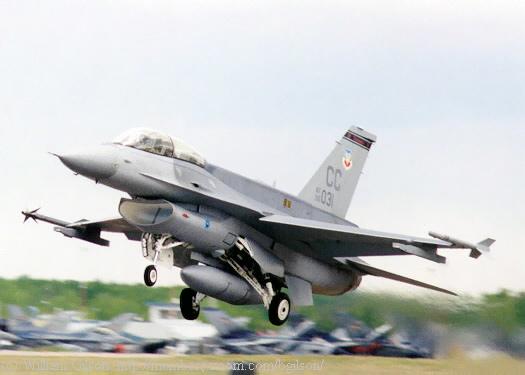
Peace Carvin IV
On July 21st, 2000, Singapore revealed that it was up to ordering another 20 F-16s. At first it was not clear whether it would be a mix of C-models and D-models, but eventually the Singapore government decided to make it an all D-model lot. Just like the D-models from the Peace Carvin III aircraft, these will be equipped with the extended spine to accommodate an extensive ECM-suite. Deliveries of the aircraft will commence at the end of 2003. The aircraft are of the Block 52 variant, powered by the Pratt&Whitney F100-229 engine. All aircraft were received before the end of 2004.
| Program | Model | Block | Qty. | Serials | Delivered |
|---|---|---|---|---|---|
| Peace Carvin I | F-16A | Block 15OCU | 4 | 880/883 | 1988 |
| F-16B | Block 15OCU | 4 | 885/888 | 1988 | |
| Peace Carvin II | F-16C | Block 52 | 8 | 608/615 | 1998 |
| F-16D | Block 52 | 10 | 623/638 (random nrs.) | 1998 | |
| Lease & Buy | F-16C | Block 52 | 4 | 600 series | 1999 |
| F-16D | Block 52 | 8 | 600 series | 1999 | |
| Peace Carvin III | F-16C | Block 52 | 10 | 600 series | 2000-2002 |
| F-16D | Block 52 | 2 | 691/692 | 2000-2002 | |
| Peace Carvin IV | F-16D | Block 52 | 20 | 661/680 | 2003-2004 |
Modifications & Armament
Dorsal Fairing
The 10 F-16D Block 52 aircraft ordered in 1994 have the same dorsal fairing as the Israeli IF-16D and the sole VISTA aircraft. It is rumored to house the SPS-3000 EW suite. The dorsal spine were installed during regular routine assembly while these aircraft were on the production line in Fort Worth.
Armament and Helmet Mounted Sight
It is rumored that the Israeli's have provided the RSAF with a first batch of short-range IR-guided Python 4 missiles. Recent pictures have shown the RSAF vipers flying with the DASH-3 HMS integration sensors attached to the canopy. DASH-3 (or any other HMDS) is essential to exploit the full potential of the Python 4, however the presence of the DASH-3 sensors does not confirm the availability of Python 4 missiles. Python4 can be fired without the HMDS and DASH can be employed to slave quite a number of other sensors (FCR, TGP, etc.) to the pilot's sight.
Singapore has acquired the AGM-84 Harpoon anti-ship missile for use on its F-16 and Fokker 50 aircraft.
In view of neighboring Malaysia upgrading its MiG-29s allowing integration of the Vympel R-77 AR-homing AAM, Singapore acquired about 100 AIM-120 missiles. Previous requests for the AIM-120 by Singapore and other countries in the region were turned down by the US government until a similar system was introduced in the region. It is understood that the AIM-120 misseles are stocked in the US, and will only be shipped to Singapore when the state is threatened. The latest reports confirm these AMRAAM missiles being in-country.
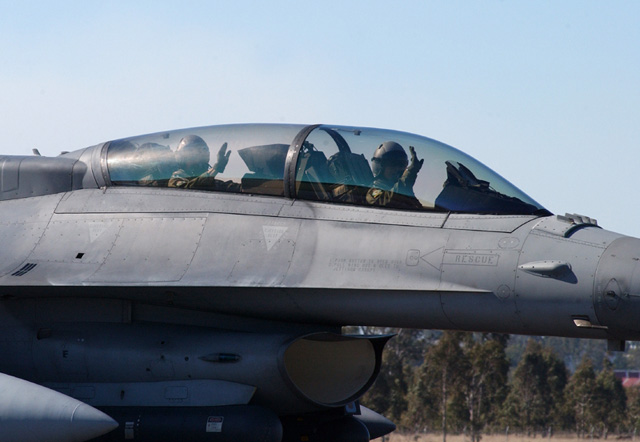
Operational Service
Units
Please refer to the F-16 Units section for an overview of units.Special thanks
- Ray Ho;
- Nazareth;
- Eric Wenden;
- Viper_40;
- Mike Yeo.
Please use this form to add any list any error or omissions you find in the above text.
Note: your comments will be displayed immediately on this page. If you wish to send a private comment to the webmasters, please use the Contact Us link.

